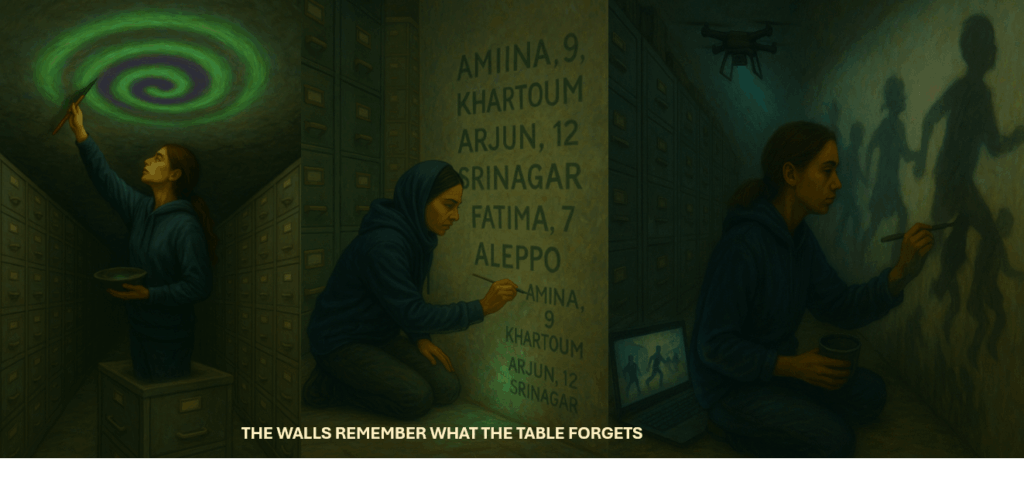
Date: October 17 – November 3, 2027
Location: Sub-Basement Level -3, UN Headquarters, New York
They weren’t allowed in the archives.
So they went anyway.
At 2:14 a.m. on the seventeenth of October, seven kids in navy hoodies slipped past the night guards, carrying nothing but two tins of Sudanese ash-ink, a box of reed brushes, and the green LED tarp rolled like contraband.
They found the door marked:
ARCHIVES – RESTRICTED
Emil pressed the gray stone against the electronic lock.
It clicked open.
(No one ever figured out how.)
Down three flights of concrete stairs — the air metallic, thick with dust and decay — they reached a corridor of filing cabinets taller than people.
Millions of pages.
Seventy-eight years of resolutions, ceasefires that never held, genocide reports filed and forgotten.
Aisha unrolled the green tarp across the floor.
The LEDs flickered to life — soft teal breath-light rising like mist in the dark.
Layla opened the first tin of ash-ink and whispered the rule they had made on the plane from Sudan:
“We only paint what we carried in our bodies.”
And they began.
-
Emil painted the Kashmir mountain line he’d traced with a dying soldier’s finger in 2026.
-
Sofia drew the violet spiral from the burned clinic wall.
-
Jaden rendered the gray stone in 1:1 scale — life-size, floating in midair.
-
Priya projected drone footage onto the wall, painting shadows of children running from artillery.
-
Mina added the green pulse circles from every rooftop they had ever sat on.
-
Aisha wrote the names — not of nations, but of the unheard:
Amina, 9, Khartoum.
Arjun, 12, Srinagar.
Fatima, 7, Aleppo.
They painted for seventeen nights.
Security tried to stop them on night four.
The guards arrived with flashlights and orders — but found the Brazilian ambassador already sitting cross-legged on the floor, watching Sofia paint.
He waved the guards away.
By night nine, half the permanent missions were sending junior diplomats “just to observe.”
By night twelve, the Secretary-General herself brought coffee and sat on an overturned crate.
The corridor transformed.
What had once been a tomb of paper became a living wound.
Every wall bled memory — ink and light, sorrow and resistance.
The green pulse on the floor synced with the heartbeat of whoever stood closest.
On the final night, Layla climbed atop a filing cabinet and painted one sentence across the ceiling in dripping violet:
THE WALLS REMEMBER WHAT THE TABLE FORGETS
Then, directly above the sentence, she drew a single, perfect green spiral.
When the LEDs pulsed, it appeared to breathe.
At 4:07 a.m. on November 3, they rolled up the tarp, packed the brushes, and left the basement exactly as they had found it —
except now, it was alive.
The Aftermath:
That morning, the French ambassador canceled a scheduled veto.
He asked if he could hold his next bilateral in the basement instead of Conference Room 1.
The Russian delegate arrived with a thermos of tea and stayed three hours without speaking.
By week’s end, the Security Council schedule quietly shifted —
“Memory Basement Sessions” appeared as a permanent informal agenda item.
Journalists who managed to sneak in called it simply:
The Memory Basement.
No one ever cleaned the walls.
No one dared.
The marble upstairs was learning it had a heart after all.
And the heart was underground — painted in ash by seven kids who still weren’t old enough to rent a car.

